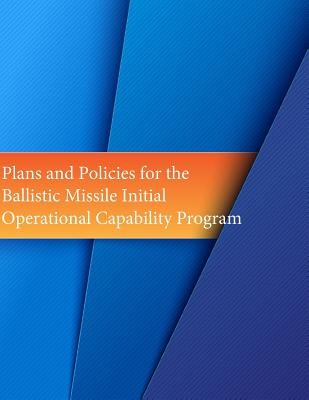
- We will send in 10–14 business days.
- Author: U S Air Force
- Publisher: CreateSpace Independent Publishing Platform
- Year: 2015
- Pages: 138
- ISBN-10: 150884190X
- ISBN-13: 9781508841906
- Format: 21.6 x 28 x 0.8 cm, softcover
- Language: English
- SAVE -10% with code: EXTRA
Plans and Policies for the Ballistic Missile Initial Operational Capability Program (e-book) (used book) | bookbook.eu
Reviews
Description
The development, production, and operational deployment of intermediate-range and intercontinental ballistic missiles probably constitutes the most intensive, complex, and expensive military program ever undertaken in American history. Certainly, it far exceeds in scope any other program attempted during a peacetime period. The objective of the program was far more than just the attainment of operational weapon systems. The continuance of peace, an uneasy one to be sure, and the very future and well-being of the "free world" depended in large measure upon a successful and energetic prosecution of the ballistic missile program.The United States Air Force, apprised through the media of several special studies of both the urgent requirement for rocket-propelled missiles and of recent major technological advances and possibilities, responded in 1954 with the establishment of a unique organization and management structure to carry out the importantjob. The structure was designed to harness the composite skills, knowledge, and facilities of the military service, the scientific world, and American industry in a major, concerted effort. No less important, the Air Force expected the new approach to compress the development-production-operation cycle by eliminating much of the inherent "red tape" so characteristic of the coordinating and decision-making processes at the various echelons of command and control.The Secretary of Defense and the President took special measures at their levels. They established special units and instituted special procedures--all for the purpose of easing the management task.They assigned the highest priority ratings to the program and removed likely areas of administrative impediments. Finally, they kept themselves intimately informed on each step of progress during the course of the program.
- Author: U S Air Force
- Publisher: CreateSpace Independent Publishing Platform
- Year: 2015
- Pages: 138
- ISBN-10: 150884190X
- ISBN-13: 9781508841906
- Format: 21.6 x 28 x 0.8 cm, softcover
- Language: English English
The development, production, and operational deployment of intermediate-range and intercontinental ballistic missiles probably constitutes the most intensive, complex, and expensive military program ever undertaken in American history. Certainly, it far exceeds in scope any other program attempted during a peacetime period. The objective of the program was far more than just the attainment of operational weapon systems. The continuance of peace, an uneasy one to be sure, and the very future and well-being of the "free world" depended in large measure upon a successful and energetic prosecution of the ballistic missile program.The United States Air Force, apprised through the media of several special studies of both the urgent requirement for rocket-propelled missiles and of recent major technological advances and possibilities, responded in 1954 with the establishment of a unique organization and management structure to carry out the importantjob. The structure was designed to harness the composite skills, knowledge, and facilities of the military service, the scientific world, and American industry in a major, concerted effort. No less important, the Air Force expected the new approach to compress the development-production-operation cycle by eliminating much of the inherent "red tape" so characteristic of the coordinating and decision-making processes at the various echelons of command and control.The Secretary of Defense and the President took special measures at their levels. They established special units and instituted special procedures--all for the purpose of easing the management task.They assigned the highest priority ratings to the program and removed likely areas of administrative impediments. Finally, they kept themselves intimately informed on each step of progress during the course of the program.


Reviews